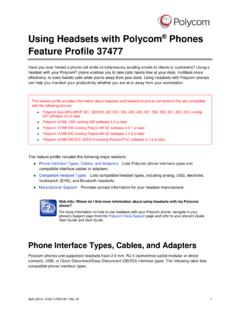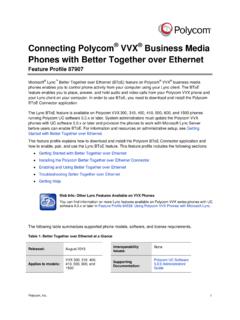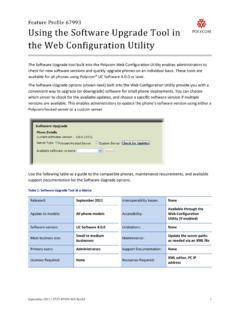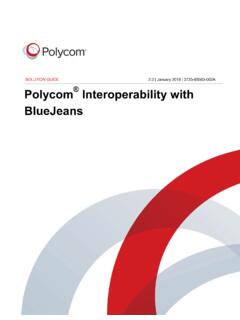Transcription of Provisioning Guide How to Provision a Polycom Phone
1 1 Provisioning Guide How to Provision a Polycom Phone This Guide shows you how to Provision a Polycom Phone with the minimum se ttings required to place and receive Voice over internet protocol (VoIP) calls over IP networks. This document assumes: You have no prior familiarity with Polycom phones. If you are familiar with Polycom phones, se e the Polycom UC Software Administrators Guide for full details on how to provisi on multiple Polycom phones and configure all Phone features. The provisioni ng process outlined in this document is compatible with Polycom Unified Communications Software (UCS) version or later. You are set up with one of Polycom s call server partners. Polycom phones support the FTP, TFTP, HTTP, and HTTPS protocols for file Provisioning and are configured by default to use File Transfer protocol (FTP).
2 The example configuration in this Guide will use FTP, a network protocol used to transfer files over the internet . The Provisioning information in this Guide applies to the following Polycom phones: SoundPoint IP SoundStation IP SoundStation Duo VVX 500 busi ness media phones , and VVX 1500 business media phones. Getting Started This se ction shows the first steps you need to perform to begin Provisioning . The Provisioning method discuss ed in this Guide use s FTP and a personal computer (PC) as the Provisioning server. To begin, you need to install and set up tools on your PC and gather some information. Turn on the Phone Provide power to the Phone using a Power over Ethernet (PoE) switch, if available, or, if no PoE switch is available, using an external power adapter and a network cable to connect the Phone to your network.
3 Install and set up the following tools on your PC: Ensure that you have an XML editor, such as XML Notepad 2007, installed on your computer. How to Provision a Polycom Phone 2 If you have an FTP server application installed on your computer, launch it now. If not, you will need to inst all one. FileZilla and wftpd are free FTP applications for windows and vsftpd is typically available with all standard Linux distributions. Once installation is complete, launch the application. Create a root FTP directory on the Provisioning computer with full read and write access to all directories and files. You will be placing Provisioning files in this root directory. In your FTP server application, create a user account for the Phone to use and take note of the user name and password as you will need these later in the Provisioning process.
4 Note: Add FTP as an Exception to Your PC Firewall When setting up your FTP server, you may need to add the FTP server as an exception to the computer s firewall to allow the IP Phone to communicate with the FTP server. Gather the following information: SIP Server address This is the hostname or IP address of the call server that handles VoIP services on your network. SIP account information This may include SIP credentials such as a user name and password, and the Phone s registration address. Although a use r name and password are not required to get the Phone working, Polycom st rongly recommends using them. You will need to obtain SIP account information from your sy stem administrator. MAC address This is a Phone s unique 12-digit se rial number just above the Phone s bar code on a label on the back of the Phone .
5 Your computer s IP address To use your PC as the Provisioning boot server, you will need your computer s IP address. Jot this number down as you will need it at the end of the Provisioning process. Downloading the Configuration Files After setting up your Phone and FTP server and gathering the information you need, your next step is to download the Polycom UCS files. Current build archives include both the split and combined UCS versions. The split files are available for specific Phone models, have a smaller size, faster update time, and reduce internal network traffic during reboots and updates. Note that if you use the split files, you will not be able to upgrade legacy phones. The combined files are a larger size and contain software files for all Polycom Phone models.
6 All configuration files are sa ved in compress ed ZIP file format and must be uncompressed before use . How to Provision a Polycom Phone 3 To download the configuration files: 1 Go to Polycom UC Software Support Center for up-to-date UC software versions, shown next, and locate the Polycom UC software release and supporting documentation you want. 2 Download and uncompress the combined [Combined] or split [Split] release of Polycom UC Software to the root FTP directory you created. For example, the following illustration shows the software downloads and support document listings available for UC software 3 In the root directory, open the folder named Config and identify the following three files you will be editing: (the master configuration file) 4 To simplify Provisioning , place copies of these three files in the root directory and not in a subfolder.
7 Polycom recommends editing copies of each file as a best practice to ensure that you have original template files containing the default values. 5 Ri ght click on each file, and choose Properties. On the Gener al tab, ensure that the Read-only option is not checked since you will be modifying these files, and click OK. How to Provision a Polycom Phone 4 Editing Configuration Files Next, you will edit each of the three configuration files. Once you have disabled the Read-only status of each file, open each file with an XML editor such as XML Notepad 2007. Settings: Check Configuration File Names After you have saved a file edited with an XML editor, ensure that an extension has not been added to the existing file name. By default, many XML editors will add an.
8 Xml extension or replicate an existing extension as part of the new file name. All of the files you edit and save should have the .cfg extension only. To edit the file : 1 Open , shown next. 2 In reg > , enter the SIP address assigned to the Phone . 3 Enter the SIP account use r name in reg . and password in How to Provision a Polycom Phone 5 4 In , enter an abbreviated number or text to display on the line key label for this registration. Typically, the line key label displays an extension number or a name. If you enter no value, the Phone displays the SIP address you entered in 5 Optionally, you can enter a caller ID in The value you enter here will display to others when you place a call. If you enter no value, the Phone uses the value you entered in 6 Save the file to your FTP root directory and rename it in a way that identifies the purpose, Phone model, or user of the Phone .
9 For example, you can name your file or If you save your file in a location other than the root directory, be sure to prepend the file path to the file name, for example, or To edit the file: 1 Open , shown next. 2 In voIpProt > > , enter the call server information. 3 Save the file to your FTP root directory and rename it in a way that identifies the purpose, Phone model, or user of the Phone . For example, you can name your file or If you save your file in a location other than the root directory, be sure to prepend the file path to the file name, for example, or How to Provision a Polycom Phone 6 To edit the master configuration file: 1 Open , the master configuration file, shown next. 2 In APPLICATION > CONFIG_FILES, using a comma-separated list, list the and the sip- files, as shown next.
10 If you saved your files in a location other than the FTP root directory, be sure to prepend the file path to the file name of each file. How to Provision a Polycom Phone 7 3 Save the fil e to your FTP root directory using the 12-digit MAC address of the Phone as the fil e name. For example, if the MAC address of the Phone is 0004f2000001, name the fil e 4 Set security permissions on the FTP directory folder. You will need to define a user or group name and allow permissions to read, write, and modify files. Security permissions vary by organization. An example using a Windows platform is shown next: Your computer will now act as the FTP Provisioning boot server. Web Info: Advanced Provisioning with Multiple Endpoints The Provisioning procedures in this document show you how to Provision one endpoint out of the box.








